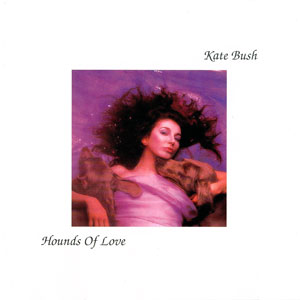
This week, I’ve been listening to Kate Bush’s fifth album “Hounds of Love” from 1985. This was really my introduction to her work. I previously only knew “Running Up That Hill” through the Placebo cover. I had listened to the original as a result, but hadn’t pursued her work any further. I expected the rest of the album to be like “Running Up That Hill.”
While that is a great song, I found the rest of the album to be wildly imaginative. Especially, the second half which forms a conceptual suite of songs. The weird track “Waking the Witch” caught me off-guard. IT opens somewhat atmospheric with various samples of people saying “wake up.” Then the songs explodes into driving synth; vocals shatter across the stereo field with extreme pulsing tremolo, overpowered by evil voices. Its this track that first made it clear to me that something of a larger narrative was happening on these songs. This and some other parts of the Ninth Wave remind me a little of contemporary Skinny Puppy.
“Running Up That Hill” opens the album with a driving percussion and synth lines. This rhythm combined with the minor key gives the song a combined sense of urgency and longing. This suits the lyrics perfectly; Bush sings about a desire for a man and a woman to swap places to feel each other’s pain. It’s really a call for empathy that she feels would only be possible through feeling through the other’s perspective.
The feeling of building urgency, though with a hint of hopelessness, is aided by the chord progression in the verses. Each bar ends with a VI-VII-I, which feels like it’s constantly approaching something but never getting there. In the relative major, this would be IV-V-iii, and IV-V is a major cadence,if it resolved back to I, but it doesn’t. This progression suggests the possibility of a major key, in fact it would be a deceptive cadence if we were in the relative major. However, we are not. This resolves back to the tonic, reminding us that we’re in a minor key.
The melody of the verses adds to this feeling by running ahead of their measure. Instead of starting on, or near, the first beat of the measure, they start half a measure earlier. This creates allows the chorus to stand out dramatically, as the melody begins directly on the first beat. After the expectations set by the verses, this means there is a lull before the chorus, which then feels like it starts a full measure early.
The track “Cloudbusting” tells a story of Wilhelm Reich and his son Peter; Inspiration came from Peter’s book “A Book of Dreams” written about his father. Patti Smith’s song “Birdland” drew on the same book. Bush’s song takes a much more sentimental perspective. I knew about Reich through William S. Burroughs, who believe much of Reich’s ideas.
Reich was an theorist, pseudo-scientist, inventory, and psychoanalyst. It was because of Reich’s ideas about orgone that Burroughs would spend time every day sitting inside a box. Regarding Reich’s ideas, Bush song mostly focuses on the cloudbuster, designed to create rain. In 1953, he apparently proved it successful at generating rain for farmers during a drought. She also incorporates the capture of Peter’s father by the feds, and the feeling of seeing his father taken away.
In Bush’s song, Peter is reminded of his late father by the rain.
Cause every time it rains
You’re here in my head
Like the sun coming out
Ooh, I just know that something good is going to happen
And I don’t know when
But just saying it could even make it happen
I also like this wonderful short verse, which is quite fitting for the controversial Reich. A later verse continues the yo-yo comparison.
You’re like my yo-yo
That glowed in the dark
What made it special
Made it dangerous
So I bury it
And forget[…]
I hid my yo-yo
In the garden
I can’t hide you
From the government
Oh, god, daddy
I won’t forget